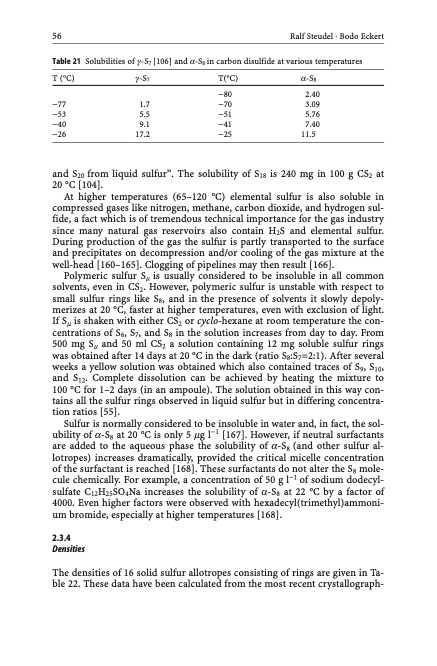
PDF Publication Title:
Text from PDF Page: 066
56 Ralf Steudel · Bodo Eckert Table 21 Solubilities of g-S7 [106] and a-S8 in carbon disulfide at various temperatures T (C) g-S7 77 1.7 53 5.5 40 9.1 26 17.2 T(C) a-S8 80 2.40 70 3.09 51 5.76 41 7.40 25 11.5 and S20 from liquid sulfur”. The solubility of S18 is 240 mg in 100 g CS2 at 20 C [104]. At higher temperatures (65–120 C) elemental sulfur is also soluble in compressed gases like nitrogen, methane, carbon dioxide, and hydrogen sul- fide, a fact which is of tremendous technical importance for the gas industry since many natural gas reservoirs also contain H2S and elemental sulfur. During production of the gas the sulfur is partly transported to the surface and precipitates on decompression and/or cooling of the gas mixture at the well-head [160–165]. Clogging of pipelines may then result [166]. Polymeric sulfur Sm is usually considered to be insoluble in all common solvents, even in CS2. However, polymeric sulfur is unstable with respect to small sulfur rings like S8, and in the presence of solvents it slowly depoly- merizes at 20 C, faster at higher temperatures, even with exclusion of light. If Sm is shaken with either CS2 or cyclo-hexane at room temperature the con- centrations of S6, S7, and S8 in the solution increases from day to day. From 500 mg Sm and 50 ml CS2 a solution containing 12 mg soluble sulfur rings was obtained after 14 days at 20 C in the dark (ratio S8:S7=2:1). After several weeks a yellow solution was obtained which also contained traces of S9, S10, and S12. Complete dissolution can be achieved by heating the mixture to 100 C for 1–2 days (in an ampoule). The solution obtained in this way con- tains all the sulfur rings observed in liquid sulfur but in differing concentra- tion ratios [55]. Sulfur is normally considered to be insoluble in water and, in fact, the sol- ubility of a-S8 at 20 C is only 5 mg l1 [167]. However, if neutral surfactants are added to the aqueous phase the solubility of a-S8 (and other sulfur al- lotropes) increases dramatically, provided the critical micelle concentration of the surfactant is reached [168]. These surfactants do not alter the S8 mole- cule chemically. For example, a concentration of 50 g l1 of sodium dodecyl- sulfate C12H25SO4Na increases the solubility of a-S8 at 22 C by a factor of 4000. Even higher factors were observed with hexadecyl(trimethyl)ammoni- um bromide, especially at higher temperatures [168]. 2.3.4 Densities The densities of 16 solid sulfur allotropes consisting of rings are given in Ta- ble 22. These data have been calculated from the most recent crystallograph-PDF Image | Topics in Current Chemistry

PDF Search Title:
Topics in Current ChemistryOriginal File Name Searched:
Elemental-Sulfur-und-Sulfur-Rich-Compounds-I.pdfDIY PDF Search: Google It | Yahoo | Bing
Sulfur Deposition on Carbon Nanofibers using Supercritical CO2 Sulfur Deposition on Carbon Nanofibers using Supercritical CO2. Gamma sulfur also known as mother of pearl sulfur and nacreous sulfur... More Info
CO2 Organic Rankine Cycle Experimenter Platform The supercritical CO2 phase change system is both a heat pump and organic rankine cycle which can be used for those purposes and as a supercritical extractor for advanced subcritical and supercritical extraction technology. Uses include producing nanoparticles, precious metal CO2 extraction, lithium battery recycling, and other applications... More Info
| CONTACT TEL: 608-238-6001 Email: greg@infinityturbine.com | RSS | AMP |